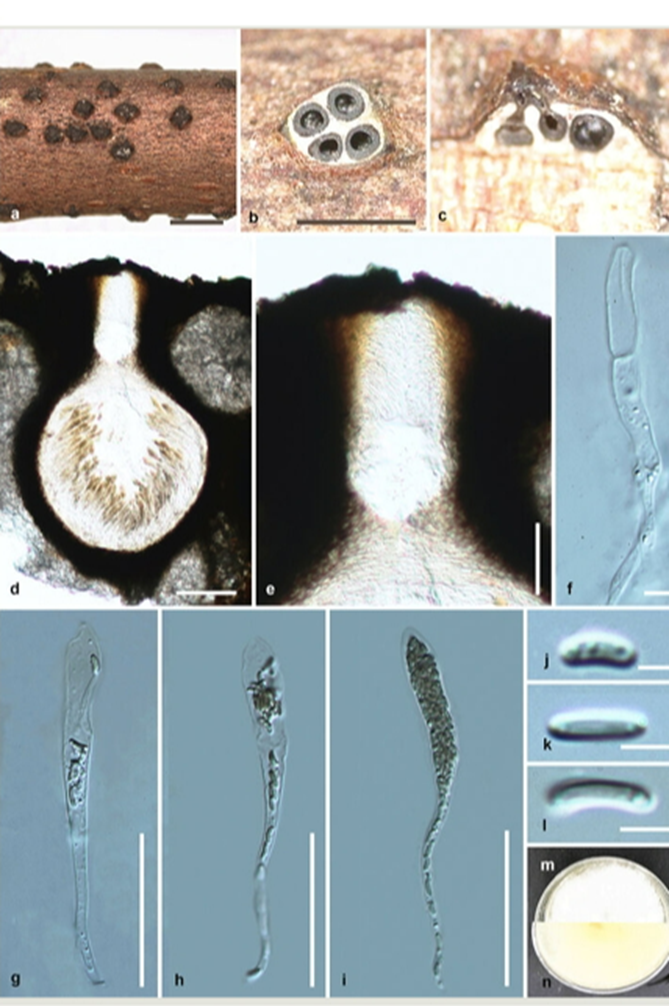 100
100
Diatrypella longiasca L.S. Dissan., J.C. Kang & K.D. Hyde, sp. nov.2021
IndexFungorum IF557952,Facesoffungi number FoF09151
Holotype: kingdom: Fungi; phylum: Ascomycota; class: Sordariomycetes; order: Xylariales; family: Diatrypaceae; taxonRank: species; genus: Diatrypella; specificEpithet: longiasca; scientificNameAuthorship: L.S. Dissan., J.C. Kang & K.D. Hyde, sp. nov.; country: China; stateProvince: Guizhou Province; county: Guiyang; locality: Guizhou University Garden (South); identifiedBy: L.S. Dissanayake; institutionID: HMAS 290656; collectionID: HMAS 290658; institutionCode: Chinese Academy of Science, Kunming and Chinese Academy of Science Herbarium; collectionCode: Kunming Institute of Botany Culture Collection; datasetName: CLD 42
Description:
Sexual morph: Stromata 0.5–0.7 mm in diam., well developed, solitary to gregarious, erumpent, black, immersed, globose to subglobose. Ascomata 525–540 μm high, 470–510 μm diam. (x = 532 × 490 μm, n = 15), perithecial, surrounded by white entostroma, immersed in stromata, 2–5 perithecia arranged in a valsoid configuration, subglobose, individual ostiole with a long neck. Neck 180–190 μm long (x = 185 μm, n = 15), cylindrical, with periphyses. Peridium 36-45 μm wide (x = 40.5 μm, n = 20), composed of two layers: outer layer of black, thick walled cells; inner layer; hyaline, thick-walled cells forming textura angularis. Hamathecium 259–287 μm wide (x = 273 μm, n = 20), composed of cells 3–5 μm wide (x = 4 μm, n = 20), paraphyses arising from base of perithecia, hyaline, long, narrow, unbranched, septate, guttulate, narrowing and tapering towards apex. Asci 105–155 × 10–16 μm (x = 130 × 14 μm, n = 30), polysporous, unitunicate, clavate, apically pointed, with a J-apical ring, long pedicellate (40–50 μm). Ascospores 4–8 × 1–2 μm (x = 6 × 1.5 μm, n = 30), overlapping, hyaline, yellowish in mass, allantoid, aseptate, guttulate, smooth-walled.
Asexual.morph:Undetermined:
Culture characteristics:Colonies on PDA reaching 21 mm diam. after 2 weeks at 20 25 C, medium dense, circular to slightly irregular, slightly raised, cottony surface; colony from above: at first white, becoming buff; from below: yellowish white at margin, yellow to brown at centre; mycelium yellowish.
Habitat: Undetermined:
Distribution:China
GenBank Accession: ITS MW036141,β-tubulin MW239659;
Notes:Diatrypella longiasca shares similar characters with D. vulgaris in having erumpent stromata through the bark often surrounded by remaining adherent epidermis or woody fragments and asci with many ascospores. However, D. vulgaris is different from D. longiasca in having longer ascospores (8–10 × 2–2.5 μm vs. 4–8 × 1–2 μm) (Trouillas et al. 2011). Diatrypella vulgaris has 4–8 ascomata per stromata, while D. longiasca comprises 2–5 ascomata per stromata. Comparison of the ITS 12% (73/570) and β tubulin 13% (56/432) nucleotide differences, phylogenetic analyses and significant morphological differences indicate that D. longiasca and D. vulgaris are distinct taxa. Thus, D. longiasca is introduced as a new species in Diatrypella, based on its morphology coupled with high support values from the phylogenetic analysis (96% ML, 0.99 BYPP, Fig. 1). A key to species related to Diatrypella longiasca is given below.
Reference: [1] Dissanayake, L. S. , Wijayawardene, N. N. , Dayarathne, M. C. , Samarakoon, M. C. , & Kang, J. C. . (2021). Diatrypella longiasca sp. nov. (diatrypaceae) from china. Biodiversity Data Journal, 9.

a. stromata on substrate; b. cross section of a stroma; c, d. vertical section through stroma showing ostiole and perithecia; e. ostiolar canal; f. paraphyses; g–i. asci; j–l. ascospores; m, n. culture on PDA from m above, n below after 6 weeks. Scale bars: 500 µm (a, b), 100 µm (d), 50 µm (e, g–i), 5 µm (f, j–l).

